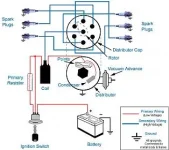UNIQUE_NAME
Well-known member
- Joined
- Aug 9, 2005
- Messages
- 614
- Status
- OWNER - I own a Hatteras Yacht
- Hatteras Model
- 38' FLYBRIDGE DBLE CABIN (1972 - 1978)
mike:
the good stb eng shows 6v ign on, didn't check while cranking. port eng shows 0v unless i physically ground the coil negative, then it shows 6v.
when i first hooked up the timing lite to the problematic port engine coil wire and cranked, the lite was sporadic at best. since moving the coil wires around there is NO spark from the coil. i have tried 2 new coils and swapped the ballast resister with the stb engine, all with the same results.
according to my schematics. 1 negative coil feed comes from inside the dist, which it does. the other goes to a ground bus. if i run a jumper wire from the coil negative to ground i get the 6v across the coil with ign on. when i found this is thought i had it solved, but still no spark when i crank. rather vexxing...
one other thing, on the good stb engine the dist housing has a braided wire screwed to the side. this braid is about 18" long and mechanically grounded to the block. the coil negative wires are run thru the middle of the braid for about 1', exit and go to the coil. the problematic port engine has the same setup except the braid is not grounded other than laying on the block.
any ideas on the purpose?
sorry for the long winded response, but i know someone has had whatever this problem is before and sooner or later something i say will ring a bell.
thanks for the patience.
jim
the good stb eng shows 6v ign on, didn't check while cranking. port eng shows 0v unless i physically ground the coil negative, then it shows 6v.
when i first hooked up the timing lite to the problematic port engine coil wire and cranked, the lite was sporadic at best. since moving the coil wires around there is NO spark from the coil. i have tried 2 new coils and swapped the ballast resister with the stb engine, all with the same results.
according to my schematics. 1 negative coil feed comes from inside the dist, which it does. the other goes to a ground bus. if i run a jumper wire from the coil negative to ground i get the 6v across the coil with ign on. when i found this is thought i had it solved, but still no spark when i crank. rather vexxing...
one other thing, on the good stb engine the dist housing has a braided wire screwed to the side. this braid is about 18" long and mechanically grounded to the block. the coil negative wires are run thru the middle of the braid for about 1', exit and go to the coil. the problematic port engine has the same setup except the braid is not grounded other than laying on the block.
any ideas on the purpose?
sorry for the long winded response, but i know someone has had whatever this problem is before and sooner or later something i say will ring a bell.
thanks for the patience.
jim


